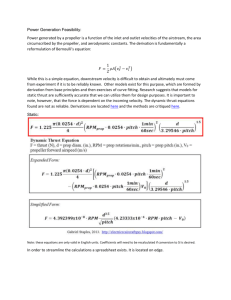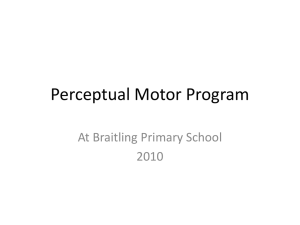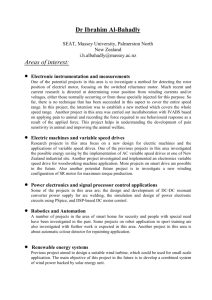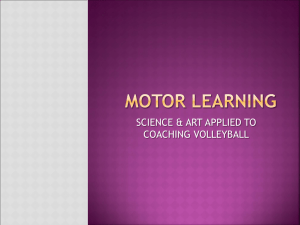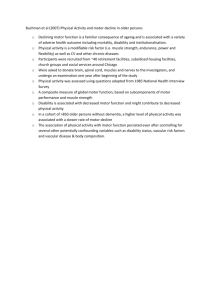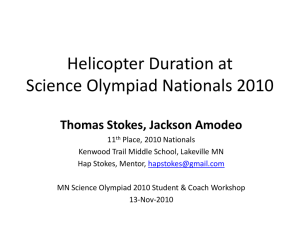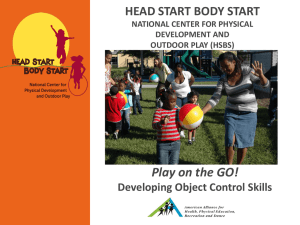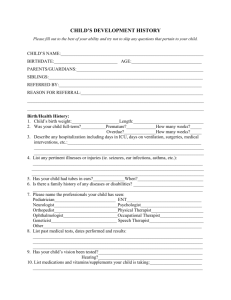references - IRD India
advertisement
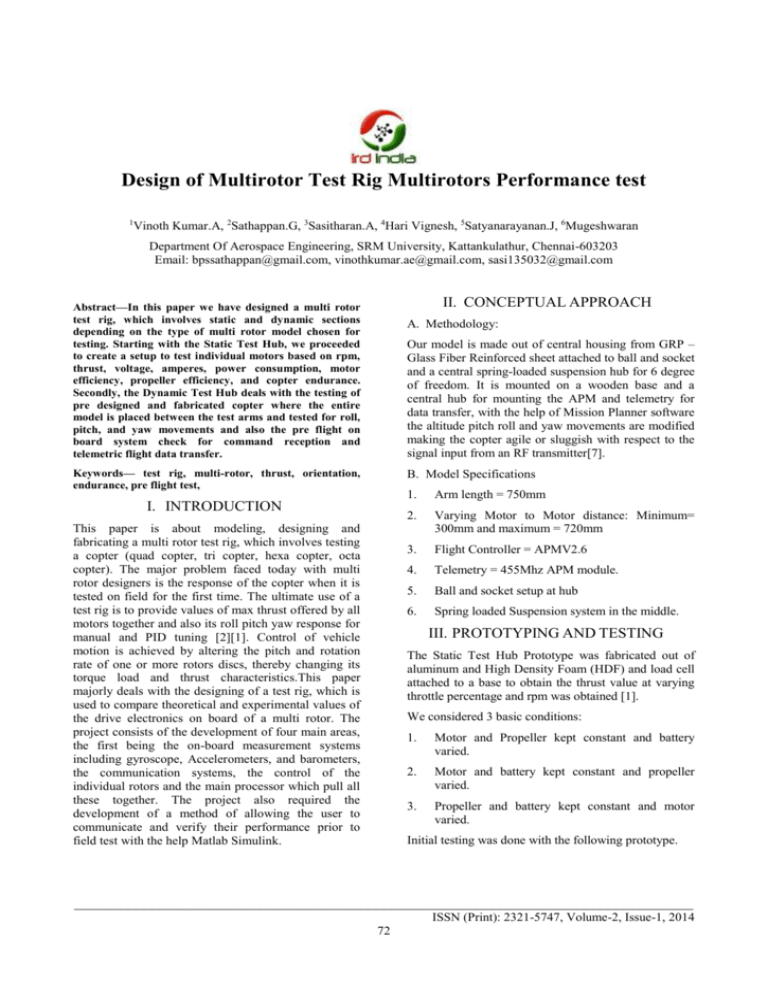
International Journal on Mechanical Engineering and Robotics (IJMER) ________________________________________________________________________________ Design of Multirotor Test Rig Multirotors Performance test 1 Vinoth Kumar.A, 2Sathappan.G, 3Sasitharan.A, 4Hari Vignesh, 5Satyanarayanan.J, 6Mugeshwaran Department Of Aerospace Engineering, SRM University, Kattankulathur, Chennai-603203 Email: bpssathappan@gmail.com, vinothkumar.ae@gmail.com, sasi135032@gmail.com II. CONCEPTUAL APPROACH Abstract—In this paper we have designed a multi rotor test rig, which involves static and dynamic sections depending on the type of multi rotor model chosen for testing. Starting with the Static Test Hub, we proceeded to create a setup to test individual motors based on rpm, thrust, voltage, amperes, power consumption, motor efficiency, propeller efficiency, and copter endurance. Secondly, the Dynamic Test Hub deals with the testing of pre designed and fabricated copter where the entire model is placed between the test arms and tested for roll, pitch, and yaw movements and also the pre flight on board system check for command reception and telemetric flight data transfer. A. Methodology: Our model is made out of central housing from GRP – Glass Fiber Reinforced sheet attached to ball and socket and a central spring-loaded suspension hub for 6 degree of freedom. It is mounted on a wooden base and a central hub for mounting the APM and telemetry for data transfer, with the help of Mission Planner software the altitude pitch roll and yaw movements are modified making the copter agile or sluggish with respect to the signal input from an RF transmitter[7]. Keywords— test rig, multi-rotor, thrust, orientation, endurance, pre flight test, B. Model Specifications I. INTRODUCTION This paper is about modeling, designing and fabricating a multi rotor test rig, which involves testing a copter (quad copter, tri copter, hexa copter, octa copter). The major problem faced today with multi rotor designers is the response of the copter when it is tested on field for the first time. The ultimate use of a test rig is to provide values of max thrust offered by all motors together and also its roll pitch yaw response for manual and PID tuning [2][1]. Control of vehicle motion is achieved by altering the pitch and rotation rate of one or more rotors discs, thereby changing its torque load and thrust characteristics.This paper majorly deals with the designing of a test rig, which is used to compare theoretical and experimental values of the drive electronics on board of a multi rotor. The project consists of the development of four main areas, the first being the on-board measurement systems including gyroscope, Accelerometers, and barometers, the communication systems, the control of the individual rotors and the main processor which pull all these together. The project also required the development of a method of allowing the user to communicate and verify their performance prior to field test with the help Matlab Simulink. 1. Arm length = 750mm 2. Varying Motor to Motor distance: Minimum= 300mm and maximum = 720mm 3. Flight Controller = APMV2.6 4. Telemetry = 455Mhz APM module. 5. Ball and socket setup at hub 6. Spring loaded Suspension system in the middle. III. PROTOTYPING AND TESTING The Static Test Hub Prototype was fabricated out of aluminum and High Density Foam (HDF) and load cell attached to a base to obtain the thrust value at varying throttle percentage and rpm was obtained [1]. We considered 3 basic conditions: 1. Motor and Propeller kept constant and battery varied. 2. Motor and battery kept constant and propeller varied. 3. Propeller and battery kept constant and motor varied. Initial testing was done with the following prototype. ________________________________________________________________________________ ISSN (Print): 2321-5747, Volume-2, Issue-1, 2014 72 International Journal on Mechanical Engineering and Robotics (IJMER) ________________________________________________________________________________ Fig 1 Prototype of testrig A. observations The observation was done with varying propeller initially and the results are specified below. 1) First set of testing TABLE I. Motor= 1000kv; Propeller= 8x4.5 Thrust (grams) Prop Speed Theoretical Practical % Error 2200 31.61354803 36 12.2 Prop Speed 6180 Thrust (grams) Theoretical Practical 487.2309497 466 6820 593.3714777 585 1.4 7245 669.6296837 680 1.5 8020 820.5530309 840 2.3 9168 1072.277336 1150 6.8 % Error 4.6 Fig 3 Graph plot of theoretical and practical values (10x4.5) 3) Third set 18.6 Prop Speed 2004 Motor=1000kv; Propeller=9x4.7 Thrust (grams) Theoretical Practical % Error 39.00912638 35 10.2 307 20.2 2720 71.86353855 64 12.3 336.5385246 428 21.4 3830 142.4847346 125 14.0 7788 395.7614904 505 21.6 4720 216.3987696 198 9.3 8481 469.8097276 590 20.4 5220 264.6743139 240 10.3 9981 650.6927825 820 20.6 6000 349.6820107 360 2.9 3200 66.88486195 80 16.4 4222 116.4298496 142 18.0 5092 169.3575913 208 6124 244.9617311 7178 TABLE III. Fig 2 Graph plot of theoretical and practical values (8x4.5) 2) Second set Prop Speed 2500 Motor=1000kv; propeller=10x4.5 Thrust (grams) Theoretical Practical % Error 79.73296875 70 13.9 3362 144.1960406 125 15.4 4360 242.5106948 217 11.8 5370 367.8802634 345 6.6 Fig 4 Graph plot of theoretical and practical values (9x4.7) IV. MODEL DESIGN TABLE II. The test rig was basically designed to accompany models of diameter varying from 300mm diameter to 1000mm diameter. The model is designed to offer 6 degrees of freedom with the help of a spring-loaded suspension attached to a ball and socket at the central hub below the copter. It is designed to constrain any degree of freedom depending on our need. The catia design is shown below: ________________________________________________________________________________ ISSN (Print): 2321-5747, Volume-2, Issue-1, 2014 73 International Journal on Mechanical Engineering and Robotics (IJMER) ________________________________________________________________________________ V. DESIGN METHODOLOGY The design process starts by setting up various constraints based on the application: In this case propeller diameter provides the necessary constraints. In practice, the propeller span defines the overall span of the multi rotor. Using the propeller diameter, one can estimate the characteristics of the propeller in term of thrust, drag and power for a range of angular speeds [3]. So, the mass, the drag moment and the thrust/weight ratio are enough to fully define the motor power requirements. This allows us to choose the range of data that are required to power the copter Fig5 Multirotor test rig(left) , Test rig stem with ball and socket (right) A. Static Test Hub: The static test hub is designed to accompany various types of multi rotor configuration from bicopter to octa copter. 1) Material: Rubber Wood 2) Diameter: 200mm 3) Hub thickness: 10mm Fig 8 Data Logging VI. CONTROL SYSTEM DATA LOGGING Fig 6Static Test Hub (octa configuration) The flight controller setup on the hub is the APM V2.6, consists of barometer, gyroscope and accelerometer sending in data of roll yaw pitch and altitude of the copter [6]. B. Dynamic Test Hub The dynamic test hub is meant to test a complete model rather than testing fitting the rotor to the static hub. The model arms are placed between the vertical support rods of the dynamic hub and constrained with the help of disc locker [1]. A. Sensor Data Output Fig 9 Pitch curve – pitch response Fig 10 Roll curve- roll response Fig 7 Dynamic Test Hub with locking disk ________________________________________________________________________________ ISSN (Print): 2321-5747, Volume-2, Issue-1, 2014 74 International Journal on Mechanical Engineering and Robotics (IJMER) ________________________________________________________________________________ V = IRm +Kvω (2) WhereV is the voltage drop across the motor, Rm is the motor resistance, ω is the angular velocity of the motor, and Kv is proportionality constant (indicating backEMF generated per RPM). This description of the motor tis used to calculate the power it consumes. The power is P = IV = ((τ+ τKt I0) (Kt I0Rm +τRm+ KtKvω))/ Kt2 (3) Fig 11 Yaw curve-yaw response B. Power Data Output For the purposes of simple model, assume a negligible motor resistance. Then, the power becomes proportional to the angular velocity. In order to extract the data of voltage input to motors from battery and the outburst current of the electronic speed controllers to the brushless motors, a wattmeter is placed between the battery and electronic speed controller, when the motor rpm increases, we considerably see the change in current drawn and voltage input from the battery to motor via ESC. Thus battery-monitoring circuitry measures motor voltage and current. Data is captured to the computer using an Atmel microprocessor to measure the analog signal at 400 Hz [5]. P≈( τ + KtI0) Kvω / Kt (4) Further simplifying the model, we assume that Kt I0 ≪τ. This is not altogether unreasonable, since I0 is the current when there is no load, and is thus rather small. In practice, this approximation holds well enough. Simplified equation for power is obtained P≈ Kv Kt τω (5) The power is used to keep the multi copter aloft. By conservation of energy, we know that the energy the motor expends in a given time period is equal to the force generated on the propeller times the distance that the air it displaces moves (P · d t = F · d x). Equivalently, the power is equal to the thrust times the air velocity P=Tυh (6) Assume vehicle speeds are low, so vh is the air velocity when hovering. We also assumed that the free stream velocity, v∞, is zero (the air in the surrounding environment is stationary relative to the quadcopter). Momentum theory gives us the equation for hover velocity as a function of thrust, Fig 12 Wattmeter data- battery discharge rate C. Motor Data Output The motor rpm is found by attaching a reflective thin sticker on the motor and using a tachometer the rpm of the motor at varying throttle is obtained. The Entire test rig is mounted on a load cell providing us with the total thrust offered by the motors in required units i.e. in kilogram or ounce. Thus the calculated value via Matlab GUI is verified with the practical values. υh= √ T 2ρΑ (7) Where ρ is the density of the surrounding air and A is the area swept out by the rotor. Using our simplified equation for power, we can then write D. Mathematical Calculation 3 Brushless motors are used for all multi copter applications [4]. For electric motors, the torque produced is given by τ = Kt(I − I0) P= T2 √2ρΑ (8) Note that in the general case, τ = ⃗r × ⃗F; in this case, the torque is proportional to the thrust T by some constant ratio Kτ determined by the blade configuration and parameters. Solving for the thrust magnitude T, we obtain that thrust is proportional to the square of angular velocity of the motor: (1) Where τ is the motor torque, I is the input current, I0 is the current when there is no load on the motor, and Kt is the torque proportionality constant. The voltage across the motor is the sum of the back-EMF and some resistive loss: T=Kω2 (9) ________________________________________________________________________________ ISSN (Print): 2321-5747, Volume-2, Issue-1, 2014 75 International Journal on Mechanical Engineering and Robotics (IJMER) ________________________________________________________________________________ Thus the derived equations are added to Matlab for theoretical calculation.[9] environment, which is used to test varying inputs and obtain results [4]. In MATLAB E. Matlab GUI The various output obtained and specification of the drive electronics are provided as input values into the GUI and the corresponding output values are obtained. Fig 16 Matlab Simulink Results Thus providing the required PID values to the APM Mission Planner in order to do the manual tuning of the copter and testing its response in the test rig. Fig 13 Matlab Graphic User Interface. IX. POSSIBLE UPGRADES A. Adding strain guages: Adding strain gauges to arm joint with the central hub would help us the find the amount of stress acting at the joints and the max load the arm could withstand with fracture can be found. B. Tilt rotor accomadation: Need to develop static test arm in order to mount motor in tilt rotor configuration and test its dynamics. Fig 14 Thrust, power, efficiency graph C. Vibration and Noise reduction VII. STATIC HUB TESTING Setting up a seismometer to check the level of vibration and also attaching a microphone to record the propeller noise and finding solution to reduce it and testing it until desired results. The static hub was fabricated using rubber wood and the functionality was tested and verified with the theoretical calculation and the error percentage was taken into account. The environmental condition, room temperature, wind velocity, blade oscillation, slip factor, motor vibration, propeller material etc. weren’t taken into consideration.[8] X. CONCLUSION In the present day technology, there are various ways to build a multi rotor and fly but in order to achieve optimum results, use of multi rotor test rig is necessary. A practical solution to test the efficiency, effectiveness and airworthiness of the copter can be obtained. The calculated values via MATLAB Graphic User Interface and Simulink can be used to manually tune the PID values of the copter through APM mission planner. Various parameters such as roll, pitch, yaw, load, thrust, motor efficiency, propeller efficiency, power, outburst current, maximum voltage etc. are easily obtained in a single test and logged data are input in the data logger for auto tuning. Though there are various ways to log these data, optimum way is to create a setup, which can offer all values at once. Further many testing and tuning can be done using the test rig before hardware testing or flight-testing in order to prevent crashes and also loss of money and time. Fig 15 Fabricated Static Test Hub VIII. TUNING USING SIMULATION A. Simulation: The equations of motion describing the dynamics of the system can be used to create a simulation ________________________________________________________________________________ ISSN (Print): 2321-5747, Volume-2, Issue-1, 2014 76 International Journal on Mechanical Engineering and Robotics (IJMER) ________________________________________________________________________________ ACKNOLEDGEMENT [4] We are grateful and thankful to our project guide, Mr. A.Vinothkumar, Asst. Professor (OG), SRM University, kattankulathur, for his guidance and kind co- operation to complete this project. Andrew Gibiansky, “Quadrotor dynamics, simulation and control,” http://andrew.gibiansky.com/quadcopterdynamics, November 23, 2012. [5] Gabriel M. Hoffman,Haomiao Huang,Steven L. Waslander, andClaire J. Tomlin, “Quadrotor helicopter flight dynamics and control: theory and experiment,” AIAA Guidance, Navigation and Control Conference and Exhibit 20 - 23 August 2007, Hilton Head, South Carolina [6] Arducopter, “ Using command line interface to configure arducopter,” http://copter.ardupilot.com. [7] M. H. Jaffery, “Precision Landing and Testing of Aerospace Vehicles,” Surrey Space Center, University of Surrey, Guildoford, PhD Thesis 2012. [8] S. Bouabdallah, A. Noth, and R. Siegwart, “PID vs LQ control techniques applied to an indoor micro quadrotor,” Swiss Federal Institute of Technology, 2004. [9] N. Guenard et al., “Control laws for the tele operation of an unmanned aerial vehicle known as an x4-flyer,” in Proc. (IEEE) International Conference on Intelligent Robots (IROS’06), Bejing, China, 2006. We would also like to place on record our profound sense of gratitude to Mr. Vinayak Ram Malhotra, Asst. Professor(OG), SRM Univeristy,Kattankulathur, Chennai-603203,for providing us an opportunity to undertake a project on “Multi rotor test rig” and Mr. SM.Balakrishnan, final year Aerospace Department, SRM university, for helping us through the fabrication and testing of the test rig. REFERENCES [1] [2] [3] Srikanth Govindarajan, Taru Agarwal, and Sai Kishan R., “Design of multirotor test bench” in International Journal of Modeling and Optimization, Vol. 3, No. 3, June 2013 S. Bouabdallah et al., “Design and control of an indoor micro quadrotor,” in Proc. (IEEE) International Conference on Robotics and Automation (ICRA’04), (New Orleans, USA), 2004. J. Horton, “Low Cost QuadRotor Design,” Department of Electrnics Engineering, University of Surrey, Guildoford, Surrey, UK, Thesis 2012. ________________________________________________________________________________ ISSN (Print): 2321-5747, Volume-2, Issue-1, 2014 77
